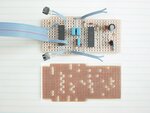ChrisHansen2Legit2Quit
Member level 2
https://www.google.com/search?q=lm3...AA&biw=1280&bih=800#biv=i|0;d|Sysg93pFat16RM:
I'm frustrated. This schematic can't get any easier.
You have to turn the POT up at least 70% to hear anything, & it's so distorted that you can barely make out what song is playing. Very quiet too. I'm at the mall & I had to leave because I couldn't hear the music (or noise, lmao) coming out of the loudspeaker.
I've swapped IC's, swapped the 1" loudspeaker for my headphones, swapped components, etc. Still very quiet. Still full of distortion.
https://www.youtube.com/watch?v=hwPg8RT82d8
I know that's probably not going to help, but there it is.
Suggestions?
The 10uF cap from pin 1 to 8. I guess many people remove that. I could not make out any difference when it was in or when I took it out.
Thanks.
D
I'm frustrated. This schematic can't get any easier.
You have to turn the POT up at least 70% to hear anything, & it's so distorted that you can barely make out what song is playing. Very quiet too. I'm at the mall & I had to leave because I couldn't hear the music (or noise, lmao) coming out of the loudspeaker.
I've swapped IC's, swapped the 1" loudspeaker for my headphones, swapped components, etc. Still very quiet. Still full of distortion.
https://www.youtube.com/watch?v=hwPg8RT82d8
I know that's probably not going to help, but there it is.
Suggestions?
The 10uF cap from pin 1 to 8. I guess many people remove that. I could not make out any difference when it was in or when I took it out.
Thanks.
D
